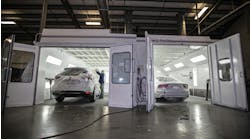All of us have painted a room or two in our homes, apartments or offices. In every case, if you were painting indoors, you used a water-based paint product called acrylic latex paint. It has little or no odor, covers well and dries fairly quickly, unless it is really humid outside. When the humidity is high, a few fans strategically placed in the room usually help it dry much faster. It’s not a very complex project to paint a room, but without proper application techniques and surface preparation, the results can be less than desirable. This is a pretty simplistic explanation of painting with a water-based product, but it is accurate for both the acrylic latex paint you use in your home, and the automotive grade of water based paint.
Although it seems as if waterborne technology is a new and mysterious thing, in reality, it has been around for decades and is used in many OEM automotive painting environments. The use of water-based paint technology has been widely accepted in Europe for a long time, and has more recently found a foothold here in the U.S. because of the lower VOCs (Volatile Organic Compounds) it produces over a traditional solvent-based refinish system.
Just so there is no confusion, the base applications are the only product currently available as water-based compound. The clears are all solvent based, although most manufacturers are developing water-based clears as well. So far, these do not have the durability needed for the automotive market, but I know of one company that seems to have cracked this problem. I am certain that in the very near future; the clear coats in these systems will be available in water.
Many collision shops today are thinking about converting to a waterborne product, but are hesitant to do so because of the negative things they may have heard about its use from some industry peers. Many shop owners look at the systems like they are contagious diseases, and they stay very far away. The reason for some of this is, initially, at its introduction, waterborne products were difficult to use, had color-match problems and were very expensive. Many shops that tried these first incarnations switched back to solvent systems very quickly because of these and other issues that arose out of what may have been premature releases of the product. Once shops tried them and found they did not work well, they are understandably very hesitant to try again today.
In reality, the paint manufacturers have invested heavily in waterborne technology and have been producing better and better products consistently in recent years. The changes in the product are staggering, and as a user of a waterborne system myself in my facility, I can say with authority that they really do work well today. They are, however, not the same as using a solvent-based system, and there is absolutely a learning curve involved, for both your painters and your production staff, in using a waterborne product.
The most important thing to understand about water-based painting systems is that they require lots of air movement in order to dry properly. I didn't fully understand this principle until I began using a water-based system, but think about it like this. In any painting operation, the painted/sprayed material dries by solvent evaporation. Common sense will tell you water evaporates much more slowly than thinner or reducer. By increasing the air movement over a painted surface, the solvent will evaporate faster. When using a solvent system, humidity in the air of your spray booth has only a small effect on the drying time of the base coats. Heat will really help the solvent evaporate quickly, so even with lower air movement and higher humidity in your booth, the base will dry fairly quickly. Not so when spraying water. If your booth does not move enough air, the base will dry at a snail’s pace, slowing down production tremendously. If there is humidity in the air, it’s really a problem. Therefore, it is very important to make certain that when you switch to water, you have your spray booth tested to make sure it moves enough air.
I know what you’re thinking. Who the heck do I call to do that? It’s really easy, and your local paint jobber should be able to do it for you, or have someone from the paint manufacturing company come to your shop. In general, if you have a clean, modern booth, it should move enough air. Each manufacturer has different metrics regarding the air movement required for their product, so you will have to refer to the paint manufacturer’s recommendations here. If you have a downdraft booth with baking capability, the heat will help the base dry faster as well. If you don't have a baking booth, you can still use water; you simply have to make sure you move enough air. The air movement in the booth, created by the booth’s exhaust fans, may not be enough to effectively dry the product, however. This will likely be the case, so you will need to move more air by using fans or venturies. I have seen the expensive retrofit fans and know that they work very well, but I was looking to try and utilize a less expensive option, so I chose to use a few sets of portable venturies and commercially available electric fans with built-in heaters. So far, they have worked very well to facilitate the base drying issue. These units are basically the same as your standard shop quartz drying lamps, but in addition to the heat lamps, they have two small electric fans mounted to the top bar. Since you are spraying a nonflammable product, using electric fans in the spray environment is perfectly OK. (Just don't use them when spraying clears and solvent-based products like primer or clears) The air venturies gobble up air, and if you are using the same compressor in your paint and body departments, you may run out of air quickly, or burn up your compressor. Most manufacturers recommend that you use a separate compressor for your paint department only, so that could get expensive. I like the electric fans for this reason, as well. I do use the venturies, but sparingly. I run my entire shop on one compressor, and it works fine. By utilizing the electric fans more often than the venturies, we can conserve air easily.
The humidity of your paint shop air is a concern as well. Waterborne paint systems require very dry air. The more humid the air in your lines, the slower the paint will dry. I have added a refrigerant dryer that is mounted just before the paint booth, which dries only the sprayable air. In addition to that, a good regulator and desiccant drier help assure Arizona-type, arid air going to the booth. With good booth air movement, dry air and good fans, the base will dry fairly quickly. To me, this is the largest issue any shop will have to overcome when working with water. You must be patient with the base coat! It naturally dries slower than solvent systems, so your staff will need to alter their production processes slightly. They will need to learn to spray on a coat of the base, turn on the fans and walk away! Leave the booth, and while the base is drying, prep another vehicle, do spray outs on the next car going into the booth, mask up another vehicle, or prime another panel. Don't watch the paint dry. If you do, your production will slow way down. The key with water is to use the base coat drying time to get other things done. Doing so will keep the line moving and flowing well.
One of the several advantages I have found with waterborne paint systems is that the color match we have been able to achieve is really very good. Obviously, tinting and spray out cards are still a staple of the painting process, but many of the formulas are right on when mixed properly. We do our best to avoid blending, since generally the blend panels in most instances are undamaged factory paint, and I really hate to get into those panels if it is avoidable. Sometimes it is not, but I feel we blend less than what I was accustomed to using a solvent-based system.
Another advantage of water-based paints is generally the coverage is much better. This saves application time and material cost because you don't need to use as much material to get good coverage. It does take a little time to get used to the look of the sprayed base material, because some times during application, the surface will look horrible, with mottles and discolorations that look like you forgot how to paint. These weird anomalies all go away as the base dries. Once your painters are acclimated to using a product, the fear of using it goes away quickly. Neither of my painters had ever sprayed water before working in my shop, and they picked it up pretty quickly. Of course, there was a learning curve, but there is with anything new or different.
Another advantage is I generate very little liquid hazardous waste in the shop. In two years of using water, in a pretty busy shop, I have only generated two 55-gallon containers of waste that had to be picked up by my waste hauling company. That's an average of one drum per year, much less that I am accustomed to generating. As you know, disposing of waste isn't cheap, so this savings was an added bonus for me. I believe the savings generated through using fewer products, not running a huge bake burner in my booth, and generating less waste more than offset any cost issues with the products. In reality, the cost of the base tints, binders, etc., for the water-based system I use are comparable to solvent. The clears I use are a little pricy, but they are made for use with the system, and as I always suggest, do not mix products or stray from what the manufacturer suggests. Using all the right products that are made for use with your system will guarantee success. If you mix and match, you won’t get a warranty-able finished product, and you more than likely will run into many other problems, as well. Cheap materials are generally cheaply made, and don't work as well.
Lastly, we all know that the water-based systems are better for the environment. The federal government understands this as well, and is in the process of drafting legislation that will, at some point, require your shop to use waterborne paints. I feel like I am doing something to help the environment by using it, so there is some satisfaction there. I also use the fact that we use water as a marketing tool, especially to hybrid owners. I do a lot of import hybrid repairs, and when I tell a prospective customer we use water-based paint technology, they just beam, and I do, too, because I get the job.
If you are opening a new shop, it just makes sense to install a water-base system at start up. If you are doing a conversion from solvent, it will be a little more challenging, but your jobber or manufacturer will help you get through the transition with as little down time as possible. Using water isn't black magic, it’s about just being open minded and willing to learn and accept its nuances.
Subscribe to ABRN and receive articles like this every month….absolutely free. Click here.




